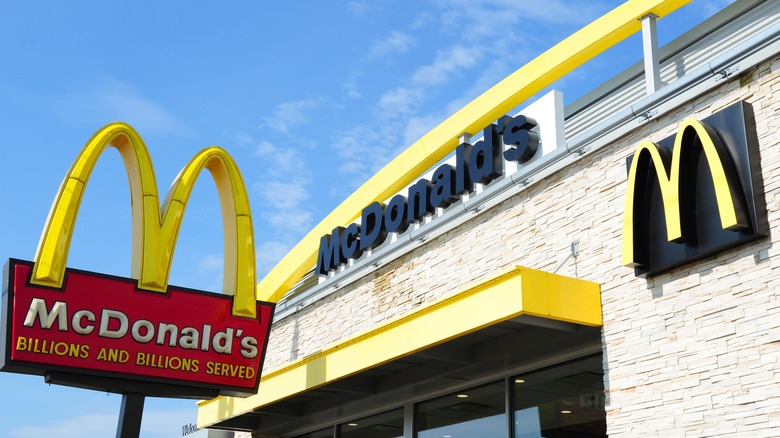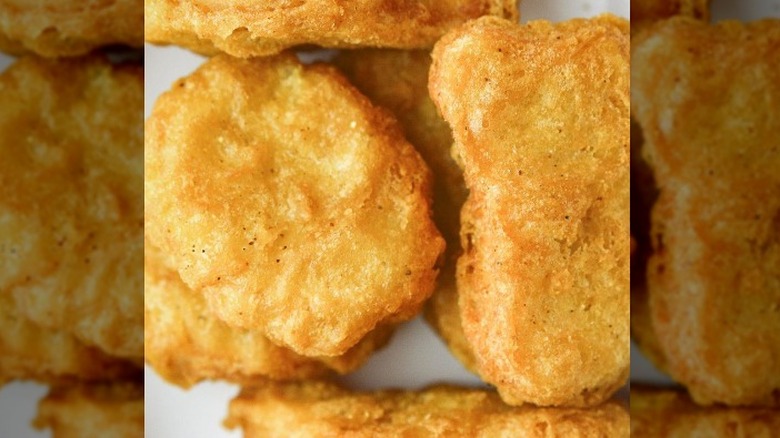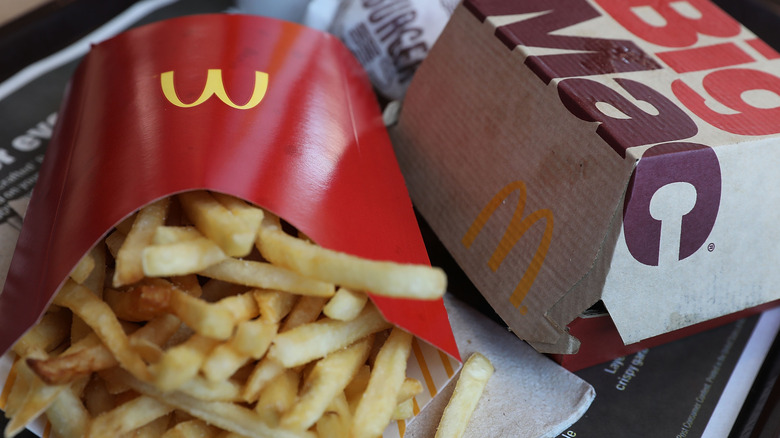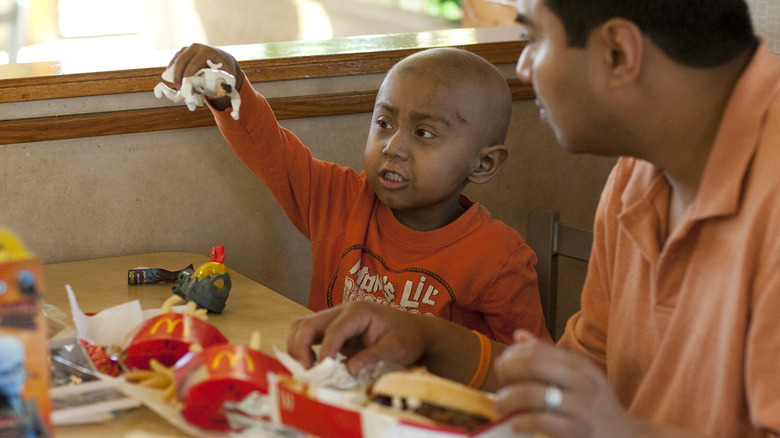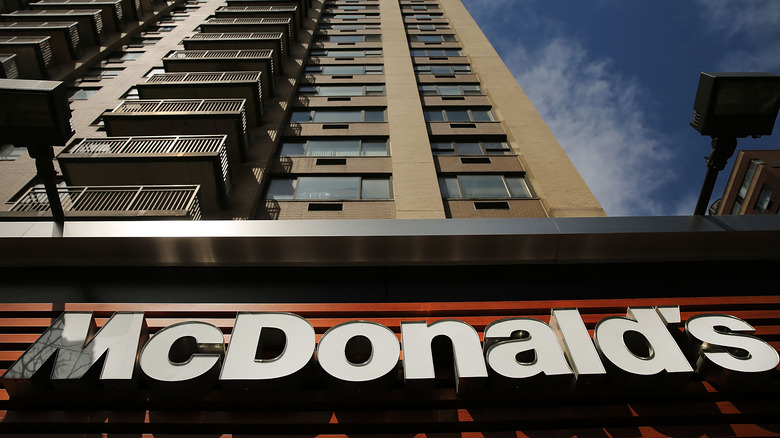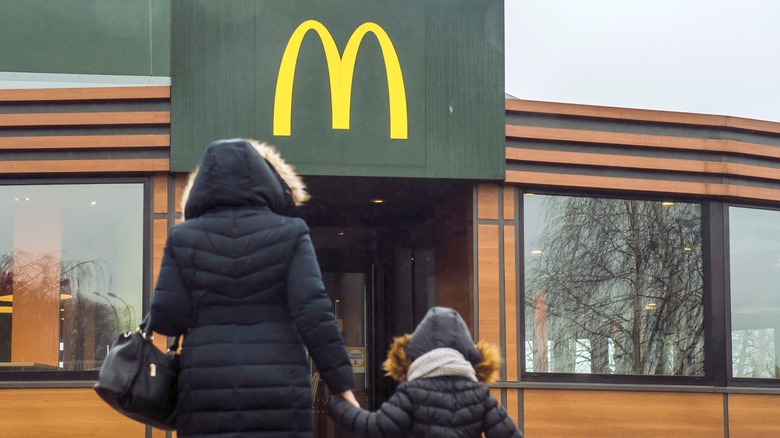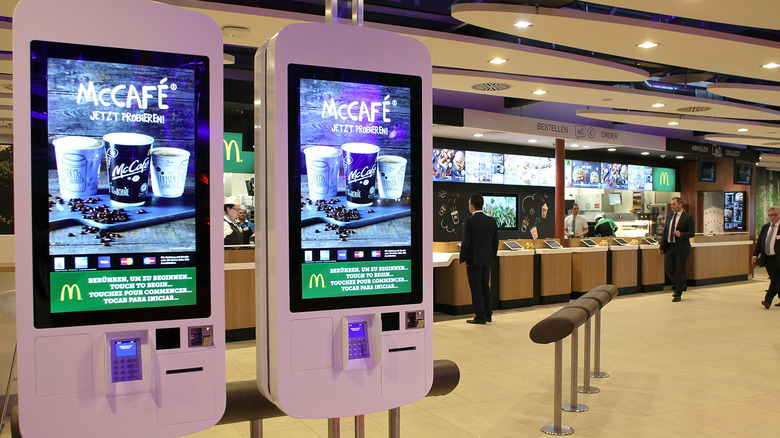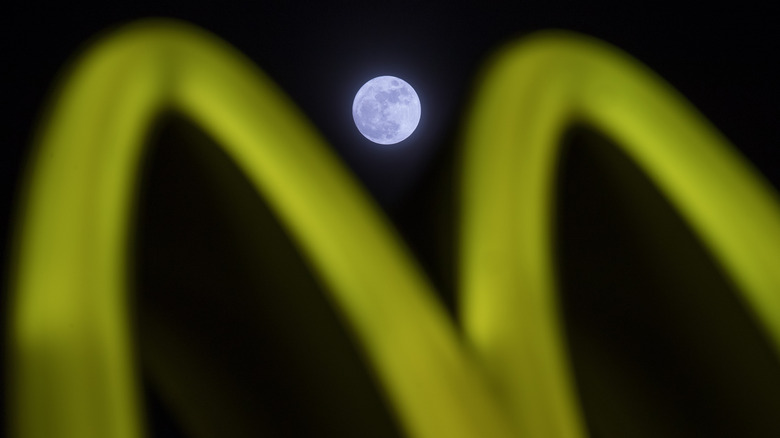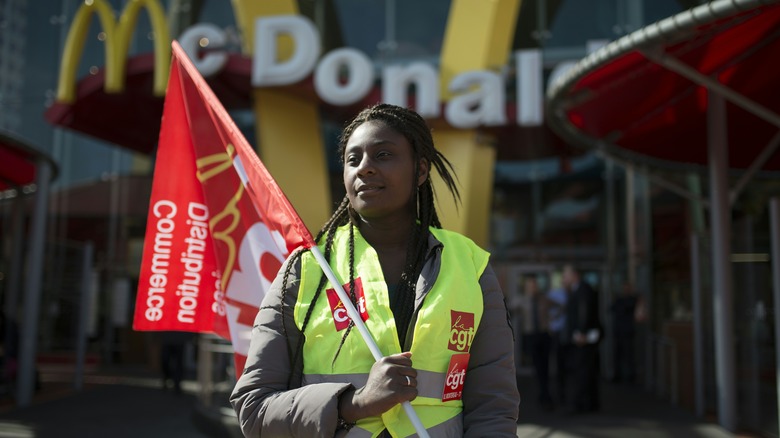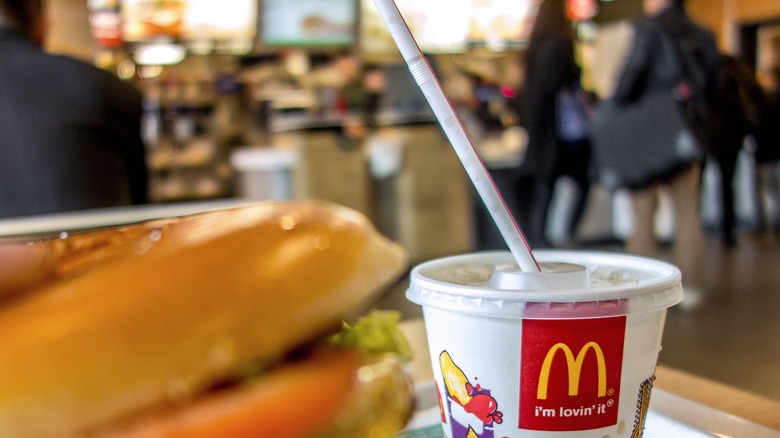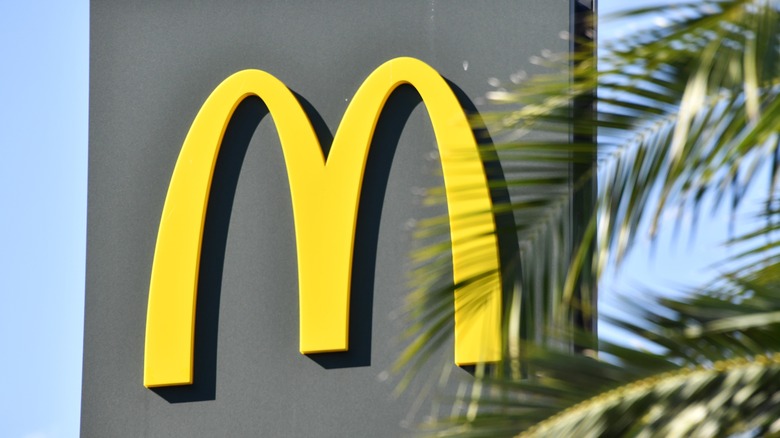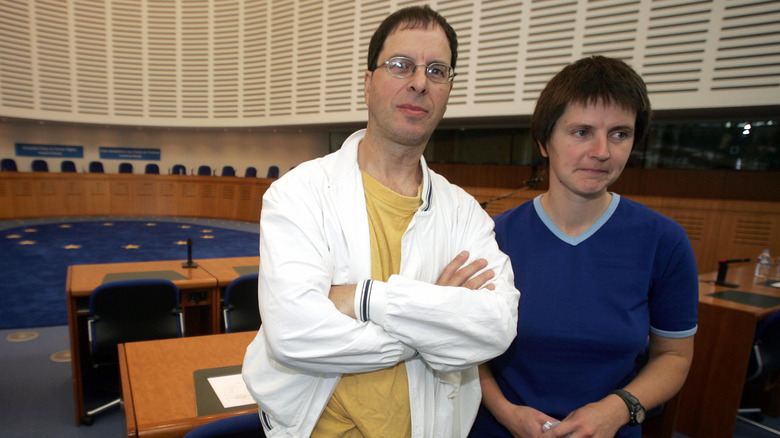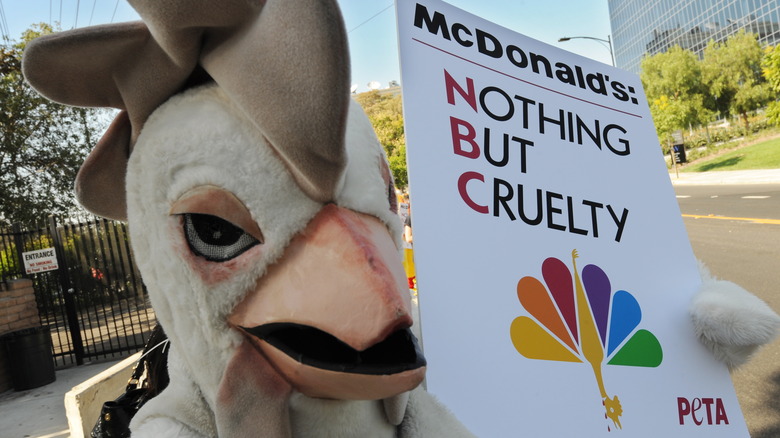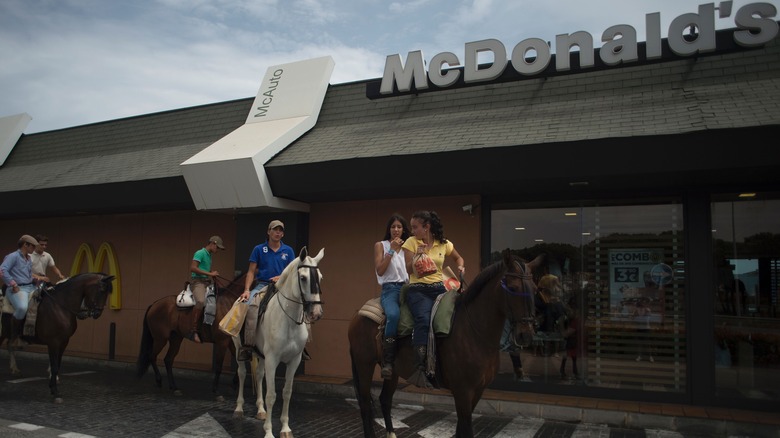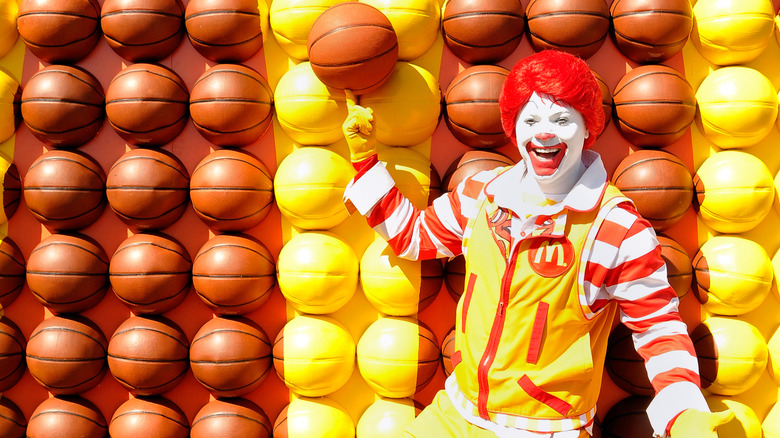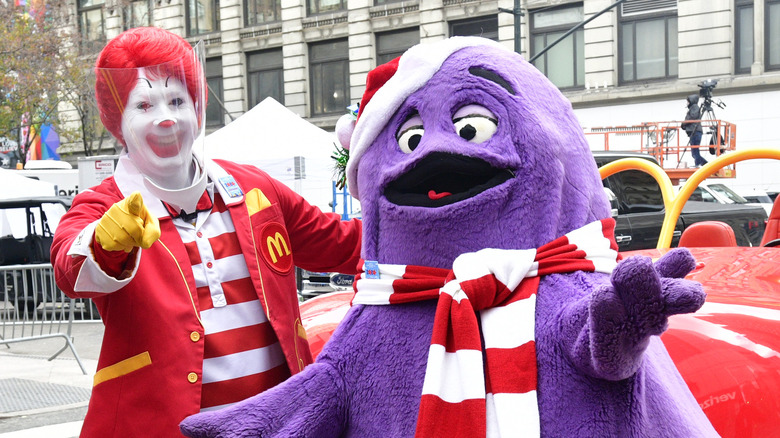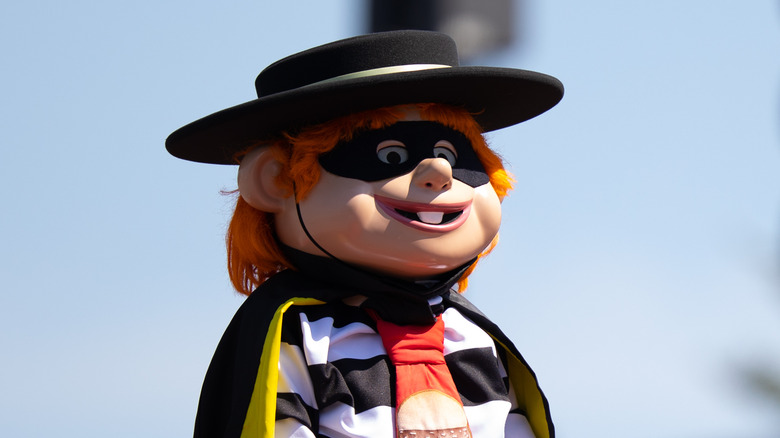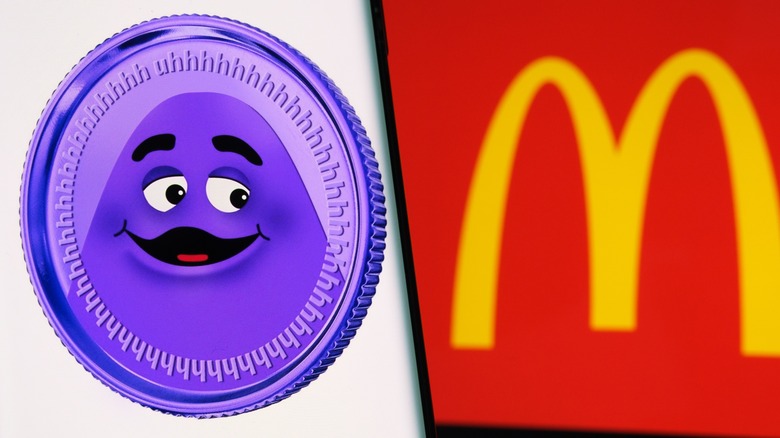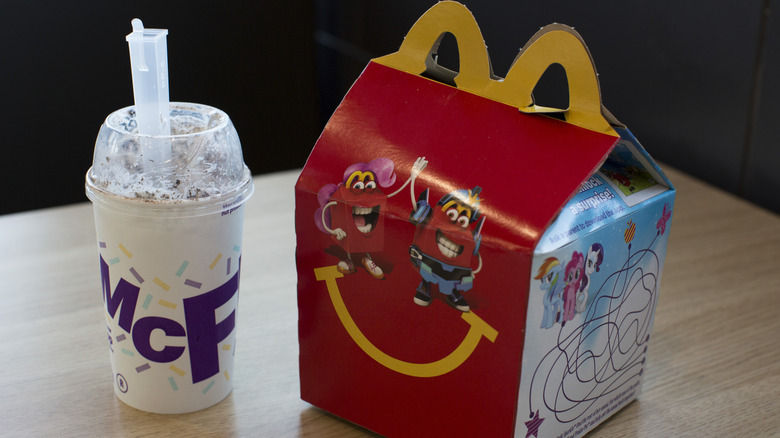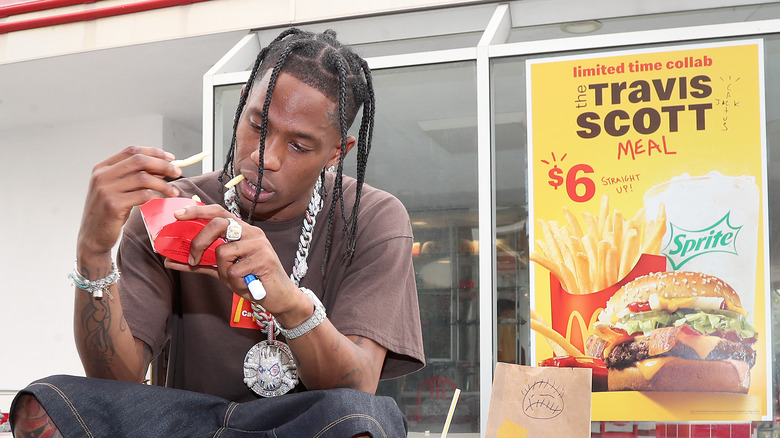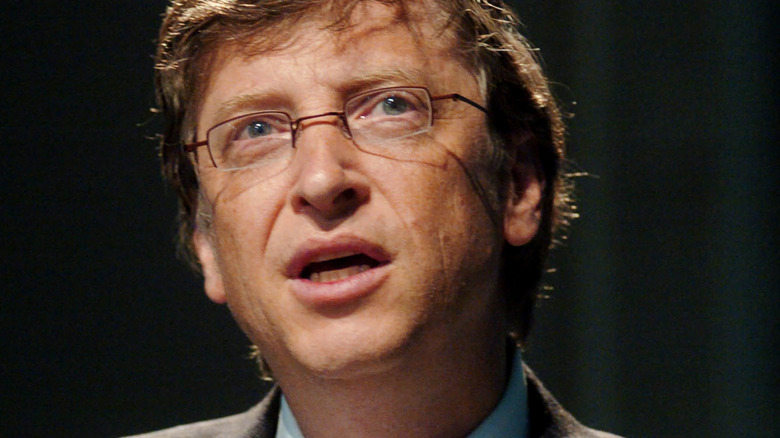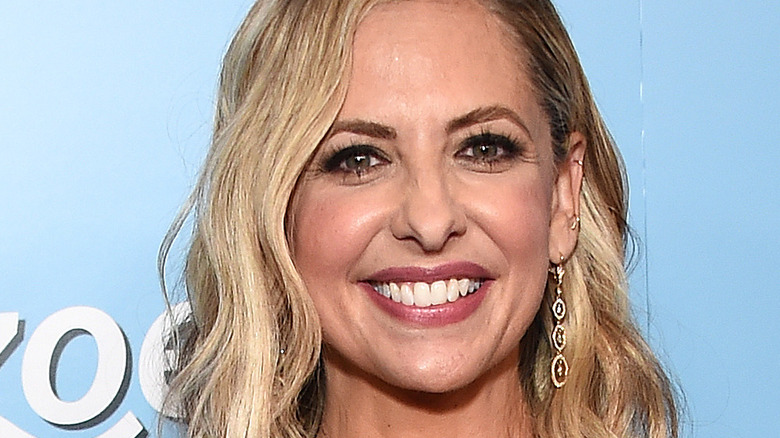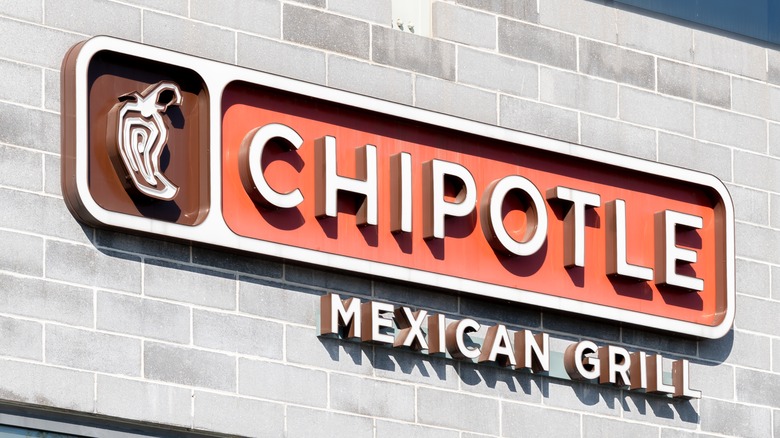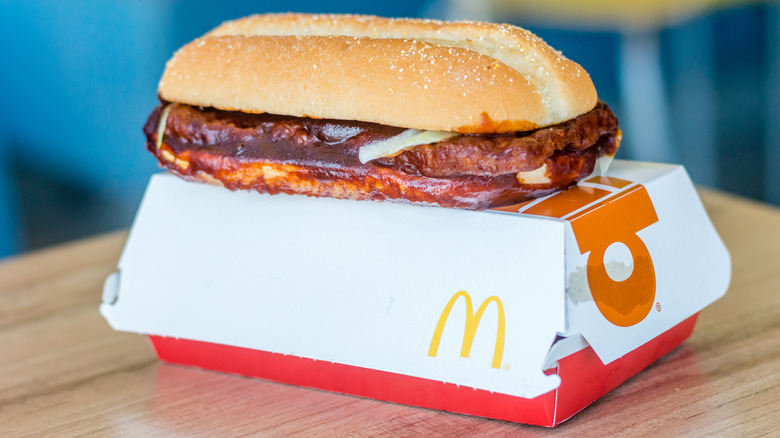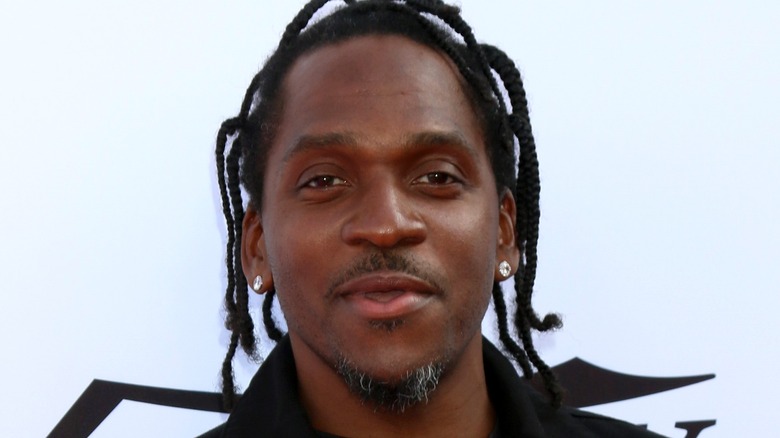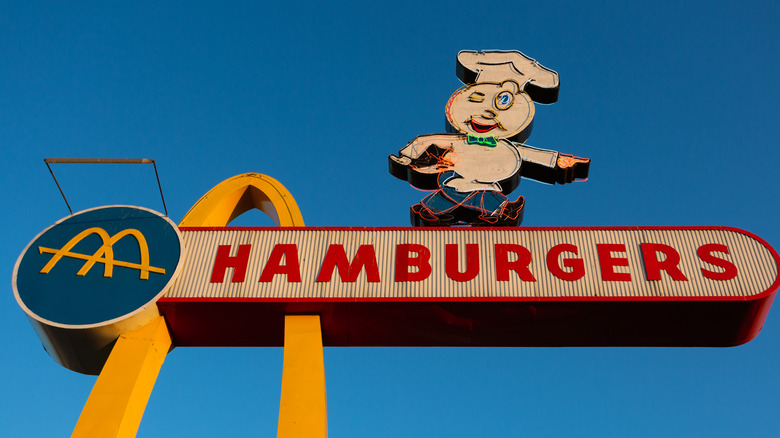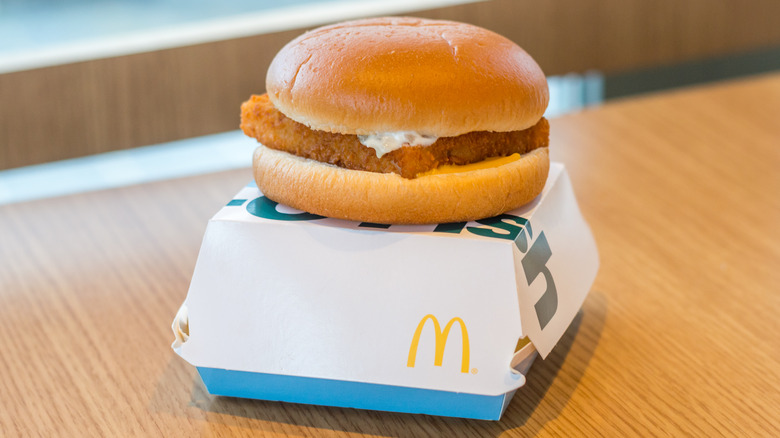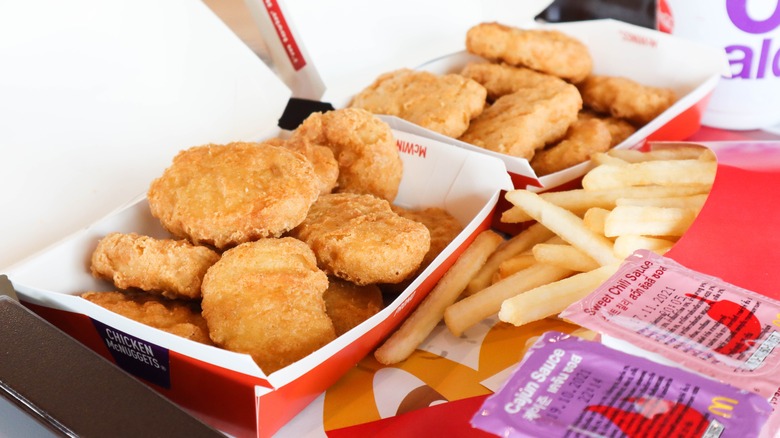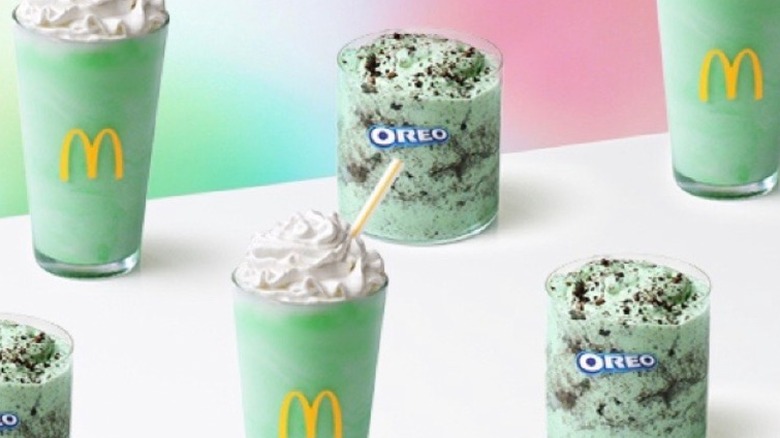The Untold Truth Of McDonald's
Everyone is familiar with McDonald's. The Golden Arches, the Big Mac, the Happy Meals ... they're the stuff of fond childhood memories and guilty pleasures well into adulthood. Because, let's be honest: sometimes, you just get a craving for a Big Mac and some fries, and there's absolutely nothing that can satisfy it but the real thing. (Although, this copycat Big Mac recipe is almost better than the real thing, and this McDonald's fries recipe is the stuff of salty dreams.)
Founded in 1940 by Richard and Maurice McDonald (otherwise known as Dick and Mac), it took an entrepreneur named Ray Kroc and a ton of drama to catapult McDonald's to the global fame they have today. According to McDonald's official history, Kroc bought out the brothers in 1961 for a cool $2.7 million — adjusted for inflation, that's about $23 million in today's money. That's a lot of money, but considering Statista says the McDonald's brand was worth over $129 billion in 2020, it's safe to say that was a good investment.
So, we know McDonald's is massive, and we know you've been there dozens of times. But ... what don't you know about McDonald's? It probably doesn't surprise you that a company this big has a ton of weird stories they try to keep quiet, so this is the untold truth of McDonald's.
McDonald's once recalled a million McNuggets
While customers Stateside might not have heard about it, McDonald's Japan had some major issues in 2014 and 2015 — issues so big and so gross that Mother Jones reported they led to a 10 percent sales decline.
It started in July 2014, when McDonald's stepped in to take some serious action against one of their chicken suppliers, Shanghai Husi Food Co. Rumor had it that the factory was mixing expired product in with the fresh stuff then shipping it to McDonald's, Starbucks, and Burger King in Japan and China— and that's just gross. Just a month later, a customer in Osaka found a piece of a human tooth in their fries, and it doesn't need to be said just how big a deal that was.
Then, in early 2015, there were several reports of customers finding pieces of plastic and vinyl in their Chicken McNuggets, leading to the recall of one million of the bite-sized chicken chunks. Their supplier, Cargill, investigated, and came to the conclusion that the contamination didn't happen in their factory. So where did it come from? We may never know... but it was there.
The McDonald's Big Mac isn't trademarked in Europe
Let's say you're opening a restaurant in New York, and you want to call one of your burgers the Big Mac. How well do you think that would work out for you? Now, if you were to open it in Spain? You'd be fine!
That's because McDonald's actually lost the trademark to the Big Mac in the European Union after a decision by the EU Intellectual Property Office (via Reuters), and this is how it happened.
The Guardian says that it was in the 1960s that Pat McDonagh was given the nickname "Supermac" during a football match in Ireland's County Westmeath. Later, McDonagh went on to open a massively successful burger chain, and he called it Supermac's. When he tried to open locations outside of Ireland, McDonald's claimed "Supermac" was too close to "Big Mac" and would lead to brand confusion. But the EUIPO ruled in favor of Supermac's, and it was a huge deal — it didn't just mean the Irish chain could expand into other countries in the EU, it also meant that the "Big Mac" trademark was void.
And that's huge, especially considering the number of McLawsuits McDonald's has previously filed and won. They even prevented a dentist from opening a practice called "McDental," and a Singapore coffee from getting the trademark "MACCOFFEE." Now, a different precedent has been set.
McDonald's was the world's biggest toy distributor
McDonald's isn't just about food, and if you have fond memories of opening your Happy Meal to see what toy you got, you're certainly not alone. Happy Meals made their debut in 1979 (and cost $1), and they've been a popular staple ever since. So popular, in fact, that The Motley Fool says that in 2004, they typically accounted for about 20 percent of sales, and that made McDonald's the largest toy distributor in the world at the time. And that's incredibly valuable: win the hearts of kids, and you not only get their parents' attention, but you have customers for life.
Happy Meals are changing with the times, too. In 2014, The Atlantic reported that because McDonald's UK ran a promotion that offered codes for e-books instead of toys, it made them — temporarily, at least — the largest book distributor in the UK. See, they can use their powers for good!
Here's a fun fact: Yes, some of those McDonald's toys are worth a decent amount of money. According to Mental Floss, if you have the late 1990s-era McFurbys, any of the early Diener Keshi figures from the late 1970s and early 1980s, any of the Monsters, Inc. toys, or full sets of the Minions toys or the 101 Dalmatians, you can make a bit of extra cash.
McDonald's is not the biggest fast food chain in the US
McDonald's is huge, and they're everywhere. But here's the really surprising thing: they're historically not the largest fast food chain in the world — not by a long shot.
First, a bit of a disclaimer: it's hard to give exact numbers, because so many locations are opening and closing all the time. So let's talk about 2017.
According to CNBC, McDonald's was only the second largest chain in the world, as far as physical locations go. While they had 37,241 restaurants, they were handily beat out by Subway and their 43,912 locations. Starbucks was a surprisingly distant third, trailing with their 27,339 stores.
But that's a bit deceptive. When it comes to sales growth, Starbucks and McDonald's were miles ahead.
And now, let's talk about 2018 and stores in the U.S. only. According to Business Insider, Subway was still at the top of the pile with around 25,800 domestic locations. But Starbucks had recently passed McDonald's, opening 14,300 stores in comparison to McDonald's roughly 14,000 U.S. restaurants.
By 2020, QSR reported McDonald's was still in third place, trailing Subway and Starbucks once again.
McDonald's doesn't make their money selling food
At a glance, McDonald's makes and sells food. So, that must be how they make their money, right? Not quite, says Quartz.
They found that a large percentage of their profits comes not from Big Macs and fries, but from real estate. Part of their franchising strategies involves buying the land the restaurant will be on, then leasing the plot to the franchisee — and about 85 percent of McDonald's locations are run by franchisees. More than that, they often lease the properties at massive markups that mean even though the average McDonald's makes around $2.7 million a year, the average take-home pay for a franchise owner is just $154,000 a year. Around 22 percent of gross profits go into rent, and the numbers are staggering.
As of 2016, McDonald's held about $30 billion worth of real estate, and that netted them an annual profit of $4.5 billion. Talk about a brilliant business plan.
The cost of doing business for McDonald's is shocking
If you've ever thought running a McDonald's franchise might be for you, here's some pretty shocking, behind-the-scenes numbers that might make you think twice — starting with the fact that Business Insider reported that McDonald's requires each one of their new franchisees to have $750,000 in liquid assets available before they'll even consider you.
Startup costs can range anywhere from $958,000 and $2.2 million, and includes everything from construction to kitchen equipment and signage. Franchisees are responsible for paying 40 percent of that with non-borrowed cash — though they do allow you to borrow the rest.
Then, franchisees pay a $45,000 franchise fee, as well as 4 percent of gross sales every month... along with rent. They're also responsible for any upgrades that need to be done to the restaurant to keep it in line with other McDonald's locations, and some of those fees are pretty shocking. A Create Your Taste kiosk will set you back $125,000, a McCafe espresso machine is a whopping $13,000, and upgrades to the interior can run up a bill as high as $600,000.
And if they decide the whole restaurant needs a remodel, you're looking at as much as $2 million. Still interested?
McDonald's based an ad campaign around a song about a murderer
If you're of a certain age, you might remember McDonald's "Mac Tonight" campaign. It's the one with the moon wearing super-suave sunglasses, and singing about how McD's was for dinner, not just lunch. But here's the weird thing: the song they picked to parody was about a criminal and murderer.
The song was Mack the Knife, made famous by 1950s star Bobby Darin. It's catchy, sure, but it's also a song based on a German song from The Threepenny Opera. That was originally a pretty graphic, incredibly violent tale about a man named Macheath (who actually dates back to 1728, says The Concourse). While McDonald's "Moon Man" sung lyrics like "When the clock strikes/Half past 6, babe/Time to head for/Golden lights," Darin had sung lyrics like "You know when that shark bites/With his teeth, babe/Scarlet billows/Start to spread." There are also entire verses about someone being drowned at the bottom of a river with a pair of cement shoes, and the ladies of the night lining up for Mack and, well, that's about as far from slinging burgers as you can get.
The campaign disappeared abruptly, and that's largely because Darin's only son sued McDonald's for $10 million. The internet never forgets, though, and the Moon Man went on to have a post-mainstream ad campaign life as a racist meme created by YTMND, a Something Awful/4chan spinoff group.
McDonald's isn't welcome in a lot of countries
There are a ton of McDonald's restaurants worldwide, but surprisingly, there are a number of cities and countries that don't have a single location. Take Florence: in 2016, The Telegraph was reporting on a lawsuit McDonald's had filed against the city after they refused to let the Golden Arches set up shop at the Piazza del Duomo. McDonald's eventually won that battle, though, and built that location in 2017.
What other areas can't get their McDonald's fix? When the U.S. military closed their base in Bermuda in 1995, McDonald's closed, too — and they haven't reopened, because of the Prohibited Restaurants Act 1977. Iran kicked them out in 1979, and instead, they're home to a chain called Mash Donald's. Macedonia and McDonald's had a falling out, and McDonald's chose to cut and run out of Bolivia after a sort of nationwide disdain for the chain resulted in poor sales.
Barbados — which traditionally doesn't eat much beef — was another failed experiment, with their McDonald's lasting just one year. There are plenty of rumors as to why McDonald's has never opened in Montenegro, and, of course, there are none in North Korea.
But most fascinating of all is Iceland, who said goodbye to McDonald's in 2008. According to Culture Trip, love for an Icelandic burger chain called Hamborgarabulla was so strong that the people boycotted McDonald's. Visitors can still stop and see the last McDonald's burger ever served, though, as it's sitting at the Reykjavik Bus Hostel, looking much the same as it did years ago.
McDonald's made a massive move to ban straws
If everyone did just one thing to help the environment, it would make a huge difference. In 2018, one-time-use plastics — particularly drinking straws — made headlines as people started to realize just how bad for the environment they are. According to Ocean Collectiv (via CNBC), they're one of the items most commonly found during beach cleanups, and the problem with getting rid of them is that alternatives are much more expensive.
But McDonald's still vowed to ditch straws, starting with their restaurants in the UK and Ireland. According to The Independent, all 1,361 locations vowed to have their plastic straws replaced by paper ones, at a much greater cost to the Golden Arches. Both government officials and customers lauded the decision — but not for long. By 2019, it was revealed that the new paper straws being used by the UK locations were no more recyclable than their plastic counterparts, due to issues with local recycling procedures.
To their credit, though, McDonald's is still trying. On their website they promise to source 100 percent of their packaging from renewable, recycled, or certified sources by 2025. By that date, they also plan to offer recycling options in all of their locations.
McDonald's accidentally-designed Golden Arches aren't always gold
Today, McDonald's Golden Arches are among the most recognizable logos in the world, but they came about pretty accidentally. According to BBC, the McDonald brothers met with LA-based architect Stanley Clark Meston to come up with a distinctive design for their buildings. On top of the flat-roofed building they had drawn up, Richard McDonald added two giant half-circles that were meant to catch the eye of passers-by — all potential customers. Those golden half-circles, along with Meston's innovative building design and a sketch by engineer Jim Schindler, would eventually morph into the "M" we all know and love today. The very first ones were installed along with the very first franchised restaurant, opened in Phoenix, Arizona in 1953.
The McDonald's logo went through a few more tweaks, and here's the weird thing: they're not all golden.
When McDonald's opened their location in Sedona, Arizona, they had to conform to local laws that served to protect the look and feel of the landscape, so their "M" is turquoise. There are similar laws in place in other areas, which means the "M" in Monterey, California is black, and those in Bruges and on the Champs-Elysees in Paris are white.
And here's a weird, fun fact you'll never be able to un-know: Freudian psychologists have suggested it's such a popular logo because it's reminiscent of humankind's original source of nourishment — breasts.
McDonald's had the longest-running legal case in English history
McDonald's is one of the parties involved in England's longest-running legal case in history, and it's just as much of a saga as you'd expect.
In a nutshell: in 1986, London Greenpeace released a pamphlet called "What's wrong with McDonald's — everything they don't want you to know." There were all kinds of accusations in it, from the mistreatment of animals to encouraging litter. In 1990, McDonald's filed their libel suit against five people. Three apologized, but Helen Steel, a part-time bar worker, and David Morris, an unemployed postal worker (both pictured), headed to court.
The pair got next to no help, and when they appealed to the European Court of Human Rights for legal aid against the millions McDonald's was throwing at them, they were essentially told they were doing well enough on their own. BBC says it wasn't until 1994 that the full trial got into motion, and spawned around 60,000 pages of documents.
It wasn't over until June 19, 1997, when the judge issued his 762-page verdict and ordered Steel and Morris to pay £60,000 in damages, finding McDonald's not guilty of many of their accusations. The pair have refused to pay, McDonald's has said they have no interest in collecting, and the case went down in history.
Your McDonald's Chicken McNuggets may have died of heart failure
Not everyone loves McDonald's, especially animal rights activists. The chain's official stance says: "We believe treating animals with care and respect is an integral part of our commitment to serving McDonald's customers safe food," and that's admirable. But animal rights groups say they're not following through on their commitments.
In 2018, Animal Equality partnered with other organizations to demonstrate at McDonald's locations and to broadcast iAnimal, a VR experience that took people "inside" factory farms to see the suffering of the chickens that ultimately made it onto McDonald's menu. They called out McDonald's not just for their policies (via PR Newswire), but for not being the leader in animal welfare they thought they should be.
According to the Independent, one of the core issues was unnatural breeding practices that resulted in chickens that got too big too quickly and ended up suffering all kinds of health issues and heart failure. All this came on the heels of McDonald's announcement (via Reuters) that they were going to be raising the standard of care for their chickens... by 2024. Is it good enough?
You shouldn't go through the drive-thru on horseback at McDonald's
Ever wonder if you could go through the drive-thru and satisfy your craving for a McFlurry while you're, say, riding a horse? If you haven't wondered... have you even really lived?
There's a surprising number of people who have not only tried, but who have made headlines for it. In March 2018, BBC reported that a man in Suffolk, England had trotted up to the drive-thru and attempted to order a McCafe latte before being told the drive-thru actually wasn't for horses. (He went inside to get his coffee.) Just a few months later it happened again, in Worcestershire. The customer wanted a Big Mac, and the horse? His name was Oliver, Express reported. They weren't served by McDonald's, but they did get a snack from a nearby Cafe Nero.
South Carolina's Isaiah Rhones had better luck, when The AJC caught him on camera going through the drive-thru for some sweet tea and apple pies (and yes, his trusty steed was the recipient of an apple-flavored treat, too).
But a McDonald's in New Zealand wasn't having any of it, when they turned away two women on horseback. According to Wide Open Pets, the chain cited health and safety reasons for turning riders away.
McDonald's isn't McLovin' Ronald McDonald anymore
For decades, Ronald McDonald has been the face of McDonald's, but in recent years... not so much, and it turns out that people have been calling for his head for a long time.
According to The Street, there was a major push back in 2011 to retire him. Why? Because, petitions said, he was being used to market unhealthy fast food items to kids, and that wasn't good. At the time, CBR says he was sort of already on his way out: McDonald's was shifting their marketing more toward adults, and had already gotten rid of most of their other McDonaldland characters. Still, Ronald was being increasingly more often lumped in with mascots like Joe Camel, who represented a company now condemned for trying to make cigarettes appeal to the youth.
And nowhere was that more visible than their ill-fated attempt to give Ronald his own Twitter account. Forbes says that when the chain decided to have their mascot tweet with #RonaldMcDonald in 2014, it went about as well as expected. There was more hate than love, and his fate was finally sealed in 2016. He was officially retired when the world started seeing people dressed as creepy, threatening clowns everywhere, and that was when McDonald's decided enough was enough.
Today, he only makes the occasional appearance — like at the Thanksgiving Day Parade (via the New York Post), and, of course, at the Ronald McDonald House Charities.
What is Grimace, exactly?
McDonald's has a slew of characters that have been featured in its advertisements for years now. Though most people associate Ronald McDonald with the fast food chain, other characters like the Hamburglar, Officer Big Mac, and Sundae have been in the mix, too. Since they're typically featured on Happy Meal boxes or plastered all over the restaurant's walls, patrons of McDonald's are definitely familiar with these characters — whether they know what each character is supposed to be or not. Ronald McDonald is obviously a clown, and Sundae is obviously a dog, but some of the other characters are a little more confusing, like Grimace. If you've ever wondered what exactly Grimace is, you're not alone. Thankfully, we have some answers.
Grimace is ... whatever you want him to be, apparently. "Whether he's a taste bud, a milkshake or just your favorite purple blob – the best part about Grimace is that he means different things to different people ... Whatever he is, we're just proud our bestie makes people happy," a McDonald's spokesperson said to CBS News, as reported by People.
If you're still at a loss, the spokesperson did specify that Grimace "is an enormous taste bud." So, there you have it. Grimace is a taste bud, but he's also whatever you want him to be.
Whatever happened to the Hamburglar?
Speaking of those fun characters, what happened to the Hamburglar? Was he finally arrested for theft? Did he team up with Plankton, another character notorious for fervently attempting to swipe a fast food patty? Did he leave behind his life of crime for one spent on the straight and narrow? Though we'd love to see McDonald's run with any of those ideas, the truth is that the Hamburglar was simply discontinued.
The McDonald's mascot, who is known for saying "Robble, robble!", has a long history with the restaurant, one that includes many iterations. He started as an old man in a stereotypical thief's costume (has anyone ever stolen anything wearing that particular outfit, though?). He's been known as the "Lone Jogger," and he's also teamed up with Captain Crook. But in the early 2000s, according to Mental Floss, McDonald's retired the Hamburglar.
Apparently, McDonald's wanted to rebrand when consumers became more concerned with eating healthy than eating inexpensively, and they deemed the Hamburglar an association with the latter. But you can't keep a criminal down for long, and in 2015, the Hamburglar was back, this time as a real person again, albeit less terrifying. Today, the Hamburglar isn't as prominent a figure in the McDonald's world as he once was, but if he makes another return, we'll be eager to learn how.
McDonald's debuted its own fake cryptocurrency
Dogecoin, Bitcoin, whatever you choose for your cryptocurrency investments, you might be turning a profit, you might be purchasing cars with it, or you might even just be investing in it for fun. Or, if you're like many of us, you're still a little confused by it all. If you've grasped cryptocurrency, though, perhaps you've considered investing in McDonald's coin.
Yes, you read that correctly. McDonald's has its own cryptocurrency. And it came about in a rather bizarre way. Its inception comes from a Twitter exchange with billionaire Tesla founder Elon Musk and the restaurant. Musk tweeted, "I will eat a happy meal on tv if McDonald's accepts Dogecoin," to which McDonald's joking replied, "only if Tesla accepts grimacecoin," as Grimacecoin, at that point, was not real.
The joke either went horribly right or horribly wrong, because now, Grimacecoin is real, and can be purchased on blockchains and traded on exchange sites. If you've been looking to buy a Tesla, perhaps Grimacecoin is your ticket to doing so (but probably not).
This is the most expensive menu item you can order at McDonald's
If a Tesla isn't in your price range but you still want to use your cryptocurrency, since McDonald's now accepts Bitcoin as payment (although only in El Salvador), perhaps you can just purchase the chain's most expensive menu item. You might have to travel to make this purchase, though.
According to Expensivity (via Forbes), to purchase the most expensive McDonald's menu item, you'll have to visit Lebanon, where a Happy Meal costs $21.98 (over six times the price of the most expensive Happy Meal in the United States). If buying expensive fast food is your thing, you could also travel to Switzerland to buy a Happy Meal for $8.53.
If you're looking for bargain food, travel to Malaysia, Egypt, or the Philippines, where they only charge $.48 for extra fries. What you save on food can go toward travel expenses. Although we like McDonald's, we're not sure we would travel that far just to have it, but we applaud anyone who does.
There have been a number of celebrity meals
Celebrities have long been used to endorse products, and McDonald's is no stranger to teaming up with the rich and famous in hopes of selling more hamburgers. The chain has paid for endorsements from celebrities like LeBron James and Heidi Klum (because if two people whose greatest investment is their body indulge in a Happy Meal, the rest of us should be able to, right?). Now, they're teaming up with celebrities in a different way — celebrity meals.
Rappers, singers, and actors have all joined forces with the fast food behemoth to create a meal that is made of menu items they're particularly fond of. For instance, Travis Scott created The Cactus Jack meal, which included a Quarter Pounder with cheese, bacon, and lettuce, a Sprite, and fries with BBQ sauce. K-pop sensation BTS curated The BTS Meal with 10 Chicken McNuggets, Cajun and Sweet Chili sauces, french fries, and a Coke.
McDonald's isn't the only fast food restaurant cashing in on the celebrity meal craze, though. Tim Hortons and Justin Bieber created their own meal, KFC and Jack Harlow have one, and Burger King and Lil Huddy have a meal together, just to name a few.
The McDonald's McGold Card can get you free food
McDonald's is apparently in the business of treating celebrities very well. If it's not paying stars for their meal collaborations, it's providing them with free food. Case in point, a select number of high-profile people are in possession of a McGold Card, per the Daily Mail.
The McGold Card does not increase your line of credit, nor does it allow you to accumulate points that can be redeemed for things like flights or cash back, but it can be used to get McDonald's food for free. Holders of these cards include people like billionaires Warren Buffet and Bill Gates, because what do two of the richest people in the world need? Access to free fast food, of course.
The terms of the card vary from holder to holder. Some are granted fast food for a year, while others have unlimited access for the rest of their life. Rob Lowe, another McGold Card holder, told Jimmy Kimmel, "This is a real thing, you guys," showing that his was valid for a year. Let that be a lesson to all. If you work hard enough and make enough money, you too could one day get free McDonald's food for life.
Sarah Michelle Gellar was named in a McDonald's lawsuit
If there's one celebrity who likely won't be getting her own McDonald's meal, it's Sarah Michelle Gellar. The actor, who's known for playing the eponymous role on "Buffy the Vampire Slayer" and Daphne in the live-action "Scooby Doo" movies, has a bizarre history with the restaurant.
A child actor, Gellar starred in a Burger King commercial in the early 1980s, in which it claimed its rival's burgers contained less meat and were fried rather than broiled. McDonald's, finding these claims misleading, sued its competitor, and Gellar's name was included in the filing.
Years later, TMZ ran a story claiming the actor herself was sued by and had been banned from the restaurant, but as the Huffington Post points out, neither is true. Though Gellar was named in the lawsuit, she herself was not sued, and she was not banned from the restaurant. As Gellar noted, "Banned is a strong word." The actor could patronize McDonald's, she just felt uncomfortable doing so. "I missed out on a lot of apple pies," she added. That, we think, is the real crime.
McDonald's used to have a stake in Chipotle
If you're a fan of Chipotle, you have McDonald's to thank. The burger joint had a large stake in the company, and its investment in the Mexican fast food chain is widely considered responsible for Chipotle's growth.
Per Bloomberg, McDonald's had invested around $340 million in Chipotle from its initial investment to when it went public, and when it sold its shares, it profited. However, had it stayed invested in Chipotle, McDonald's could've made much, much more money than it made from the sale.
The public was particularly critical of McDonald's in the mid-2010s, and at that time, Chipotle's sales were up, while its former investor's sales were down. McDonald's made every attempt to regain its popularity, including rebranding and major personnel changes, and it's clearly still in business today.
If you're looking to have your own stake in either business, Investment U names both companies in the top six fast food restaurants to buy stock in this year.
There's no actual rib in McRibs
If you're a fan of McRibs and also a fan of foods that are made with real rib meat, you'll be disappointed to learn that those categories do not overlap. In the Venn diagram of foods made with real rib meat and McDonald's menu items, the McRib is not in the middle. There are no actual ribs used in the making of McRibs.
As CNBC reports, the famed sandwich is made of ground pork that is then shaped to resemble a rack of ribs. The process of making the sandwich was shown on Mythbusters, and one of the bystanders, who was disgusted with the sandwich initially, changed his opinion after watching. "It's different now that I know what actually goes inside of it, and I know what actually the process is in terms of making it. It's actually good pork," he said.
If you're concerned about the contents of McDonald's food, take to the restaurant's website. It's surprisingly transparent about what goes into its food, assuring customers that items like the McNuggets are made with real chicken. Ironically, the McNuggets include rib meat, putting them at the center of the aforementioned Venn diagram.
Pusha T wrote McDonald's famous jingle
If you grew up in a household in the United States with a television set and watched it with even the smallest bit of frequency, there's likely a jingle or two that entered your psyche against your will. Jingles are a marketing staple in the U.S., and few other tactics seem to be as effective in raising awareness of brands. And if there's a business that's adept at marketing, it's McDonald's.
Back in 2003, McDonald's enlisted some of the biggest names in music to create a jingle, and we're willing to bet that nearly every person alive today has heard it. Though it's often credited to expert producer and hit-maker Pharrell, rapper Pusha T actually wrote the iconic McDonald's jingle "I'm Lovin' It." And because it was 2003 and few singers were as famous, the tune was sung by Justin Timberlake, per Rolling Stone.
There's no word on what Pusha T earned for his work, but Timberlake, who's now worth an estimated $250 million per Celebrity Net Worth, was compensated well for his efforts. The singer took home $6 million for voicing the jingle, which is precisely how much we'd like in damages for the song living in our heads rent-free since 2003.
McDonald's first mascot was Speedee
Long before there was Ronald McDonald, there was Speedee. And who is Speedee, you ask? Speedee was McDonald's very first mascot.
McDonald's, aiming to change the way Americans dine out, wanted to emphasize the speed at which a customer could order and receive food at its restaurants. To embody this concept, it created Speedee, an adorable little chef. Unfortunately for the tiny mascot, Speedee did not last long with the company, because it discovered that customers were associating McDonald's with its golden arches rather than the small chef on its signs. Capitalizing on this revelation, McDonald's created Ronald McDonald.
Ronald McDonald, the world's most lovable (?) clown, was not always so lovable, though. His first iteration was quite scary, much like the Hamburglar. He wore a cup for a nose and painted a second set of eyebrows resembling the famed arches on his face. Thankfully, he eventually got a makeover (though for many, he is still a little unsettling to see, admittedly).
You can thank Catholicism for Filet-o-Fish ... and the Hula Burger
All good ideas come from competition. Well, some do. But competition is what led McDonald's to sell the Filet-o-Fish, so if you're a fan of the dish, thank competition. Oh, and you can also thank Catholicism.
Back in the 1960s, Lou Groen, a McDonald's franchise owner in Cincinnati, noticed that his sales dropped sharply on Fridays, as 87% of the Cincinnati population was Catholic. In the Catholic faith, practitioners are to abstain from eating red meat on Fridays, particularly during Lent. By following this religious law, Groen's pew mates were costing him business.
"Everyone was going down the street on Fridays to Frisch's restaurant that sold a fish sandwich," Groen's granddaughter Erica Shadoin told the National Catholic Register. To make up for lost revenue, Groen began selling his own fish sandwich. Ray Kroc, McDonald's famed former CEO, contested the idea, but Groen stood firm as his fish sandwiches were keeping him in business.
Kroc created his own sandwich, the hula burger, which was a slice of pineapple and cheese on a bun, and challenged Groen to a sandwich sales competition, with the winner remaining on the menu. Groen won (and no offense to Kroc, but the hula burger sounds awful) and the Filet-o-Fish has been on the menu ever since. Per the New York Times, over 200 million Filet-o-Fishes were sold in the United States in 2012 alone, so it was clearly the right decision.
There are names for the McDonald's nugget shapes
If you didn't already know, McDonald's has a name for everything, including its Chicken McNuggets. Back in 2014, a video was released by McDonald's Canada showing just how the chain makes its famous menu item.
The video was incredibly enlightening, and the public's biggest takeaway was the contents of the nuggets. An unbelievably large amount of chicken is ground and molded into shapes before being covered in batter, partially cooked, and sent to the franchises to be thoroughly cooked and sold. What was lost in the shuffle of this intriguing process are the names of these four nugget types: the bone, the bell, the boot, and the ball.
Business Insider notes that McDonald's shared, on a now-defunct website page, why they shaped their nuggets. "Our Chicken McNuggets are shaped uniquely for kids and kids at heart – it makes dipping more fun!" The shapes also ensure uniformity, making for easier and safer cooking.
You'll be glad to know the McNuggets are actually made from chicken, as seen in the video, and not slime or goop as rumored. McDonald's has dispelled the claims on its website.
The Shamrock Shake used to be lime-flavored
McDonald's loves a good iteration. Whether it's a strange mascot or a popular milkshake, the fast food joint will make changes as it sees fit. As for the Shamrock Shake, the changes it's undergone have included its name and its flavor.
The shake, which has been sold in McDonald's restaurants across the nation since 1970, was first called the St. Patrick's Day Green Milkshake, according to Coca-Cola, and was made with lemon-lime sherbet, vanilla ice cream, and vanilla syrup. However in 1973, according to The 42, McDonald's changed the flavor of the shake to plain vanilla, adding green food coloring to keep with the theme.
Now the Shamrock Shake is mint flavored, and each year it comes with various shamrock offshoots. For example, in 2017, the seasonal drink was accompanied by the Chocolate Shamrock Shake, the Shamrock Chocolate Chip Frappe, the Shamrock Hot Chocolate, and the Shamrock Mocha. In 2022, it was sold alongside the Oreo Shamrock McFlurry. Each of those sounds worlds better than the original Shamrock Shake flavor, but we praise McDonald's for seeing the error of its ways and landing on a flavor that is now loved by many.
